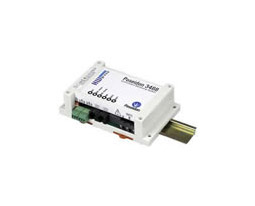Poseidon 3468 alerts the operator to critical situations (contact opened/closed, or temperature/humidity out of safe range).
Web enabled thermostat with temperature/humidity measurement, four dry contact inputs and two 110/230V relay outputs. Industrial version, supports SNMP and E-mail, DIN rail mount.
Poseidon 3468 alerts the operator to critical situations (contact opened/closed, or temperature/humidity out of safe range).
In case of an alarm, Poseidon sends an e-mail and connects to your NMS (Network Management System) with a SNMP trap.
Configuration and current sensor readings are accessible through a graphical WWW interface.
- IP thermostat function to control outputs locally
- 2 outputs rated at 250V / 16A (double-throw relay contacts)
- Connect up to 4 temperature or humidity sensors and 4 Dry Contact inputs
- When a contact is closed, e-mails or SNMP traps are sent to multiple recipients
Basic Features
- Ethernet: RJ45 (10BASE-T)
- WEB: Embedded WEB server / GUI
- Sensors: 2xRJ11 1-Wire (max 4 temperature / humidity sensors)
-
Inputs: 4 dry contact inputs (for detectors)
(Smoke, power, water leak, door contact, air flow, entry to the room) -
Outputs: 2 output relays (250V AC / 16A)
(Air conditioning, server power supply, horn / light tower) - M2M protocols: SNMP, XML
- Sending SMS: With external software only
- Physical features: dimensions: 102 x 76 x 36 [mm]
- Response to thresholds: SNMP trap, E-mail
- Built-in functions: Output controlled with an input or sensor value ("Thermostat" mode).
Applications
|
|

